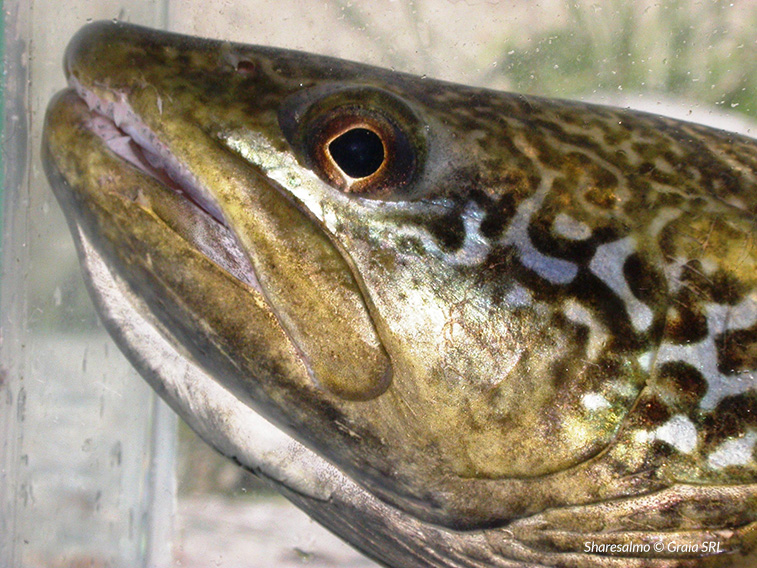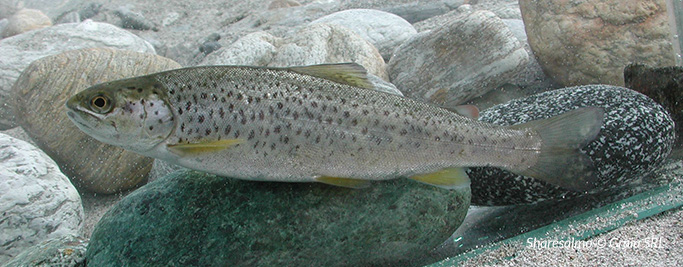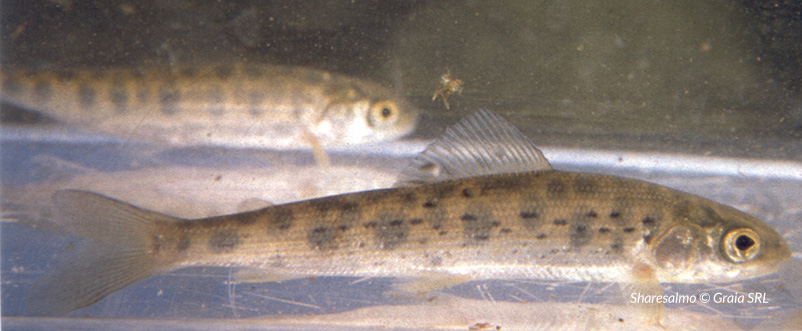Description of species, biology, ecology
Marble trout (Salmo marmoratus)
The marble trout (Salmonid family) is a species that is native to the large and medium-size waterways of the Po Valley, the pre-Alpine area, Switzerland and Slovenia. It requires fresh, well-oxygenated water with a moderate to fast current. It has an elongated body that reaches 50 cm in length on average, but can also reach one metre. It has a large head and a wide mouth. The silver-grey colouring is enhanced by a marble pattern. It is a predatory fish: juvenile fish feed mainly on invertebrates, while the diet of adult fish mainly consists of fish. The reproductive period takes place in the winter. To reproduce, the adult fish swim back up the rivers to reach the areas where the eggs are spawned. In recent decades, the species has undergone a drastic decline throughout its habitat mainly due to: the presence of impassable barriers along the rivers that prevent it from moving, the introduction of the Wels catfish (invasive non-native fish), the implementation of artificial waterways and change in water levels, the hybridisation with brown trout (fertile fish are fertilised and hatched resulting in the loss of the marbling genetics).

Lake trout (Salmo trutta lacustris)
The lake trout is not a real species, but a morphotype or ecotype of the marble trout, brown trout, and rainbow trout which spends part of its life cycle in the lakes. Since it is a salmonid, it requires fresh water with a good quantity of dissolved oxygen. It has silvery-grey colouring with small black, irregularly-shaped spots that are more or less pronounced. Its colour helps the trout to blend in the lake. The back is dark while the belly is clear. Its body is elongated, and it has a large head and a medium-sized mouth with teeth. It can reach 100 cm and over in length and weight up to 20-25 kg (but this big fishes are extremely rare today). In lake it is mainly ichthyophage. To reproduce, it swims back up the rivers to reach the most suitable breeding grounds. Once the eggs have been spawned, the adults move downstream while the young trout stay in the rivers for one to two years before descending to the lake. Not all the young trout descend to the lake; some stay in the river all their lives. Threats for this species are: river fragmentation caused by dams and barriers that avoid fish to reach the reproductive areas, overfishing (minimum fishing catch measures don’t protect reproductive specimens, so wild reproductive stock in lakes decreases), water pollution, hydroelectric drawings that often reduces water levels making rivers inhospitable for both young and adult fish.

Adriatic grayling (Thymallus aeliani)
The Adriatic grayling (Salmonid family), the so-called “blue fin grayling”, is an endemic species of the Po-Veneto area. From an environmental point of view, this fish requires good-quality, fast-flowing fresh water. It can reach 50 cm in length, has a streamlined body and medium-size head and small mouth. The dorsal fin is especially large. The colouring is greenish-grey with small black spots. The Adriatic grayling differs from the European grayling (Thymallus thymallus, a species introduced into Italy and, therefore, a non-native species) due to the bluish colour of the caudal fin. In the European grayling, known as the red fin, the caudal fin is reddish in colour and it has wine-coloured spots on its sides which the T. aeliani does not have.The Adriatic graylingmainly feeds on insects and occasionally on fish. To reproduce (in spring), it swims back up the waterways in search of shallow water where the river bed is suitable for the eggs. The blue fin grayling has virtually disappeared in Italy, mainly due to the change in water habitats, pollution and the introduction of the European grayling, a competing species.



